-
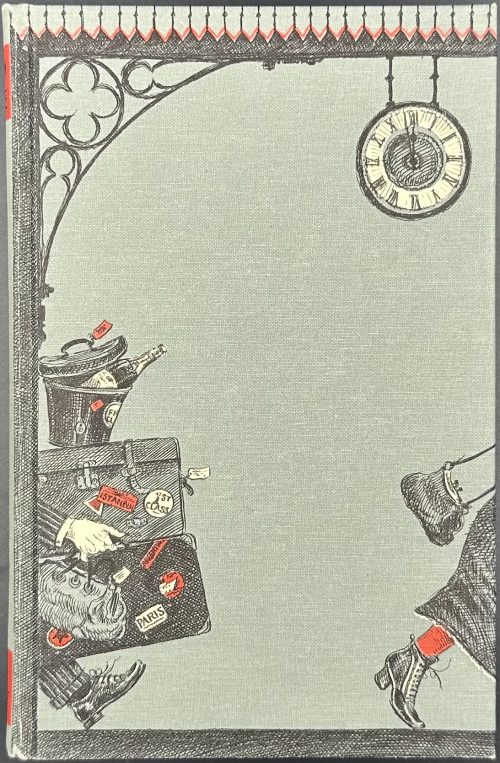 Hardcover volume, 23 x 15 cm, bound in full pictorial olive cloth, lettering to spine, in a green slipcase 23.5 x 15.9 cm; pp.: [1-4] 5- 267 [268] [4 blanks], b/w tailpieces, frontispiece and 8 colour photomechanical plates after John Holder. Title-page: GRAHAM GREENE | TRAVELS WITH MY AUNT | A Novel | Introduced by John Mortimer | Illustrated by John Holder | FOLIO SOCIETY | LONDON MMIV || Contributors: Graham Greene (British, 1904 – 1991) – author. John Mortimer (British, 1923 – 2009) – author/introduction. John Holder (British, b. 1941) – artist. St. Edmundsbury Press (UK) – printer. Hunter & Fouls (Haddington) – binder. Folio Society (UK) – publisher. For the 1st edition, see [LIB-2758.2021] Graham Greene. Travels with my aunt: a novel. — London: Bodley Head, 1969.
Hardcover volume, 23 x 15 cm, bound in full pictorial olive cloth, lettering to spine, in a green slipcase 23.5 x 15.9 cm; pp.: [1-4] 5- 267 [268] [4 blanks], b/w tailpieces, frontispiece and 8 colour photomechanical plates after John Holder. Title-page: GRAHAM GREENE | TRAVELS WITH MY AUNT | A Novel | Introduced by John Mortimer | Illustrated by John Holder | FOLIO SOCIETY | LONDON MMIV || Contributors: Graham Greene (British, 1904 – 1991) – author. John Mortimer (British, 1923 – 2009) – author/introduction. John Holder (British, b. 1941) – artist. St. Edmundsbury Press (UK) – printer. Hunter & Fouls (Haddington) – binder. Folio Society (UK) – publisher. For the 1st edition, see [LIB-2758.2021] Graham Greene. Travels with my aunt: a novel. — London: Bodley Head, 1969. -
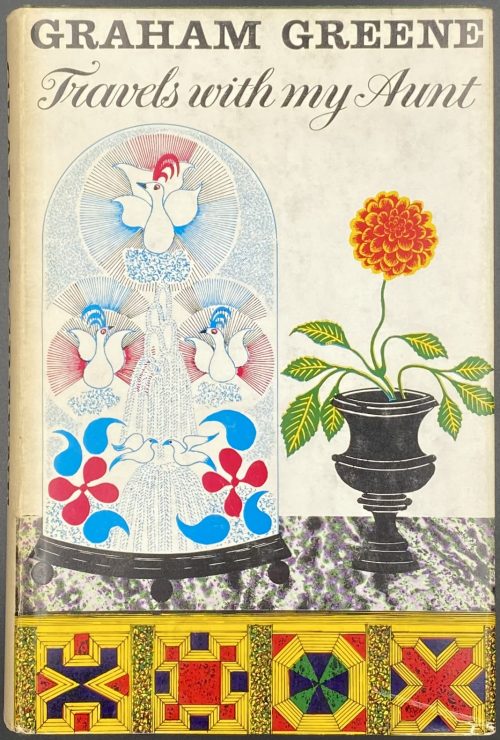 DJ: Graham Greene | Travels with my aunt || Title page: TRAVELS | WITH MY AUNT | A NOVEL | Graham Greene |{publisher’s device}| THE BODLEY HEAD | LONDON SYDNEY | TORONTO || Edition: 1st edition, 1st printing. Binding: 20.5 x 13.5 cm; publisher's green cloth, gilt lettering on spine, pictorial dust-jacket. Pagination: [1-8] 9 – 319 [320]. Collation: 16mo; [1]16, 2-1016 (total 160 leaves). Contributors: Graham Greene (British, 1904 – 1991) – author. Stephen Russ (British, 1919 – 1983) – DJ artist. The Bodley Head – publisher. William Clowes & Sons, Ltd. (Beccles) – printer.
DJ: Graham Greene | Travels with my aunt || Title page: TRAVELS | WITH MY AUNT | A NOVEL | Graham Greene |{publisher’s device}| THE BODLEY HEAD | LONDON SYDNEY | TORONTO || Edition: 1st edition, 1st printing. Binding: 20.5 x 13.5 cm; publisher's green cloth, gilt lettering on spine, pictorial dust-jacket. Pagination: [1-8] 9 – 319 [320]. Collation: 16mo; [1]16, 2-1016 (total 160 leaves). Contributors: Graham Greene (British, 1904 – 1991) – author. Stephen Russ (British, 1919 – 1983) – DJ artist. The Bodley Head – publisher. William Clowes & Sons, Ltd. (Beccles) – printer. -
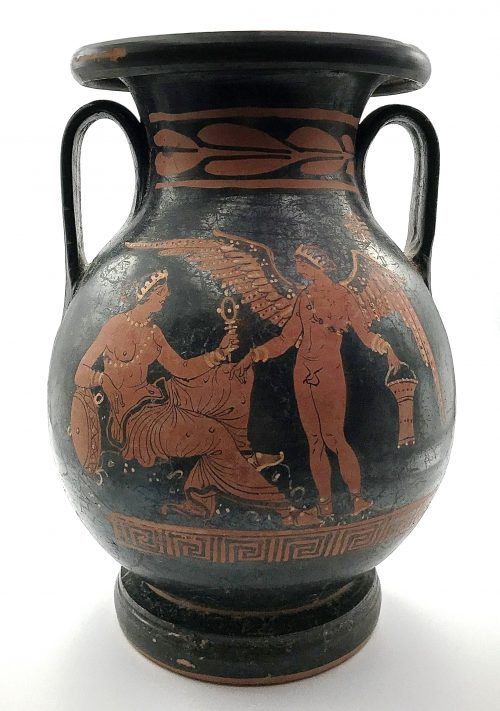 Seller provided description:"Finely painted via the red-figure technique, an elegant pelike vessel of a classic globular form with a cylindrical neck rising to a flared rim, and twin fluted handles, all upon a raised, concave, disc foot.Side A depicts a winged Eros who stands in contrapposto facing toward the left, in the nude save sandals, bracelets, a beaded sash, and a stephane (wreath) holding a situla (pail) in his left hand and gesturing toward the seated maenad before him. Though with her breasts exposed, the maenad does wear a lower garment, and is bedecked with a stephane, multiple bracelets, and strands of pearls around her neck - all delineated in fugitive white and yellow pigment. She holds a mirror in her left upraised hand and leans upon a tambourine with her right elbow. Above and to the right is a maker's mark of a circular format with a central X that is further adorned by nested wedges and dot motifs. Side B presents two opposing standing draped male figures, the gent on the left leaning upon a walking stick. Complementing the figural program, is a lovely decorative program adorning both sides of the vessel, with bands of laurel leaves above and a repeating Greek key/meander below. An outstanding example, masterfully wheel thrown, so that we see absolutely no signs of any jogs in the transitions between the different elements of the vase. Moreover, it presents ideal proportions perfect for presenting the superb painted iconographic/decorative program. The painting was executed with the utmost skill and artistry - the red-figure technique enabling the artist to delineate the figures' musculature, facial details, as well as the cascading drapery folds with extensive fugitive paint embellishments.Expected surface wear with some scuffs and pigment losses commensurate with age, but the painted program is generally very well preserved. Area of repair/restoration to cloak of male on right (Side B). Minute nick to left of male on left (Side B). Nice root marks throughout and areas of encrustation. Thermoluminescence (TL) report: the piece has been found to be ancient and of the period stated. Equivalent age: 2400 +/- 300 years. Certificate of Authenticity from Artemis Gallery. Provenance: private East Coast, USA collection. Greece, Southern Italy, Apulia, ca. 330 BCE.Size: 6.75" in diameter x 9.875" H (17.1 cm x 25.1 cm)Polina de Mauny, being both attentive and knowledgeable, was the first who noticed a possible mistake in the description above. It is highly probable that the woman on side A is not a maenad but Aphrodite herself, holding a mirror and leaning on a shield. Maenads were "often portrayed as inspired by Dionysus into a state of ecstatic frenzy through a combination of dancing and intoxication". The situla, held by Eros, unequivocally alludes to Dionysian ritual, which has to do as much with maenads as with Aphrodite. The nature of two men on side B remain unclear.
Seller provided description:"Finely painted via the red-figure technique, an elegant pelike vessel of a classic globular form with a cylindrical neck rising to a flared rim, and twin fluted handles, all upon a raised, concave, disc foot.Side A depicts a winged Eros who stands in contrapposto facing toward the left, in the nude save sandals, bracelets, a beaded sash, and a stephane (wreath) holding a situla (pail) in his left hand and gesturing toward the seated maenad before him. Though with her breasts exposed, the maenad does wear a lower garment, and is bedecked with a stephane, multiple bracelets, and strands of pearls around her neck - all delineated in fugitive white and yellow pigment. She holds a mirror in her left upraised hand and leans upon a tambourine with her right elbow. Above and to the right is a maker's mark of a circular format with a central X that is further adorned by nested wedges and dot motifs. Side B presents two opposing standing draped male figures, the gent on the left leaning upon a walking stick. Complementing the figural program, is a lovely decorative program adorning both sides of the vessel, with bands of laurel leaves above and a repeating Greek key/meander below. An outstanding example, masterfully wheel thrown, so that we see absolutely no signs of any jogs in the transitions between the different elements of the vase. Moreover, it presents ideal proportions perfect for presenting the superb painted iconographic/decorative program. The painting was executed with the utmost skill and artistry - the red-figure technique enabling the artist to delineate the figures' musculature, facial details, as well as the cascading drapery folds with extensive fugitive paint embellishments.Expected surface wear with some scuffs and pigment losses commensurate with age, but the painted program is generally very well preserved. Area of repair/restoration to cloak of male on right (Side B). Minute nick to left of male on left (Side B). Nice root marks throughout and areas of encrustation. Thermoluminescence (TL) report: the piece has been found to be ancient and of the period stated. Equivalent age: 2400 +/- 300 years. Certificate of Authenticity from Artemis Gallery. Provenance: private East Coast, USA collection. Greece, Southern Italy, Apulia, ca. 330 BCE.Size: 6.75" in diameter x 9.875" H (17.1 cm x 25.1 cm)Polina de Mauny, being both attentive and knowledgeable, was the first who noticed a possible mistake in the description above. It is highly probable that the woman on side A is not a maenad but Aphrodite herself, holding a mirror and leaning on a shield. Maenads were "often portrayed as inspired by Dionysus into a state of ecstatic frenzy through a combination of dancing and intoxication". The situla, held by Eros, unequivocally alludes to Dionysian ritual, which has to do as much with maenads as with Aphrodite. The nature of two men on side B remain unclear. -
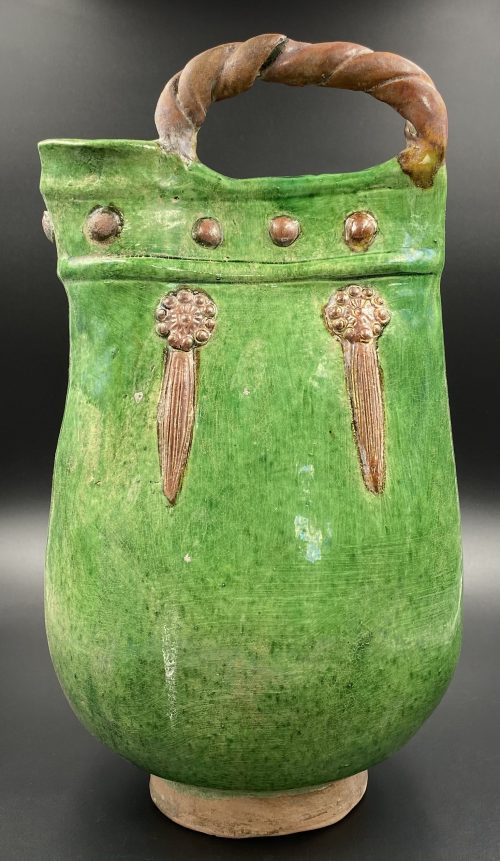 Footed purse-like ewer with twisted handle, with sculptured body glazed in green and details glazed in brown, on an unglazed foot. China, the Liao Dynasty [辽朝] (907 – 1125). Dimensions: 29 x 15 x 15 cm
Footed purse-like ewer with twisted handle, with sculptured body glazed in green and details glazed in brown, on an unglazed foot. China, the Liao Dynasty [辽朝] (907 – 1125). Dimensions: 29 x 15 x 15 cm -
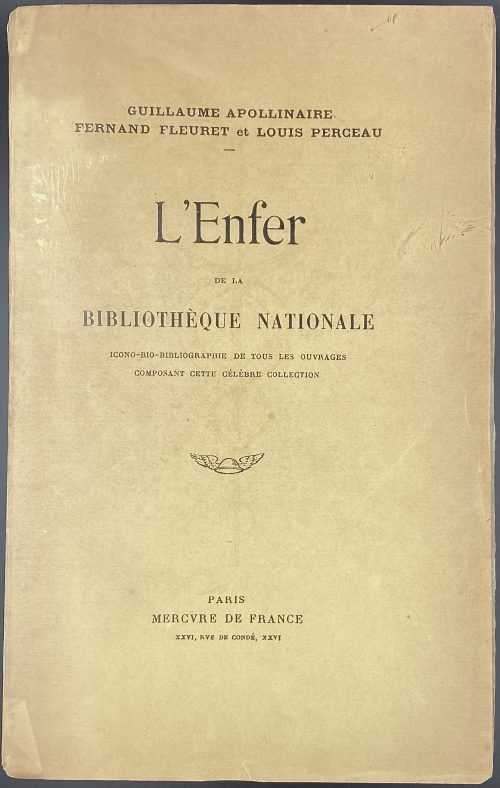 Title: GUILLAUME APOLLINAIRE | FERNAND FLEURET LOUIS PERCEAU | L'Enfer | DE LA | BIBLIOTHÈQUE NATIONALE | ICONO-BIO-BIBLIOGRAPHIE | DESCRIPTIVE, CRITIQUE ET RAISONNÉE, | COMPLÈTE A CE JOUR | DE TOUS LES OUVRAGES COMPOSANT CETTE CÉLÈBRE COLLECTION | AVEC UN INDEX ALPHABÉTIQUE | DES TITRES ET NOMS D'AUTEURS | PARIS | MERCVRE DE FRANCE | XXVI, RVE DE CONDÉ, XXVI | MCMXII || Pagination: ffl, [1-5] 6-415 [416], bfl. Collation: [1]8 2-268. Binding: Original tan wrappers, lettering to covers and spine. Edition: First edition of which this is №952. Ref.: BnF
Title: GUILLAUME APOLLINAIRE | FERNAND FLEURET LOUIS PERCEAU | L'Enfer | DE LA | BIBLIOTHÈQUE NATIONALE | ICONO-BIO-BIBLIOGRAPHIE | DESCRIPTIVE, CRITIQUE ET RAISONNÉE, | COMPLÈTE A CE JOUR | DE TOUS LES OUVRAGES COMPOSANT CETTE CÉLÈBRE COLLECTION | AVEC UN INDEX ALPHABÉTIQUE | DES TITRES ET NOMS D'AUTEURS | PARIS | MERCVRE DE FRANCE | XXVI, RVE DE CONDÉ, XXVI | MCMXII || Pagination: ffl, [1-5] 6-415 [416], bfl. Collation: [1]8 2-268. Binding: Original tan wrappers, lettering to covers and spine. Edition: First edition of which this is №952. Ref.: BnF -
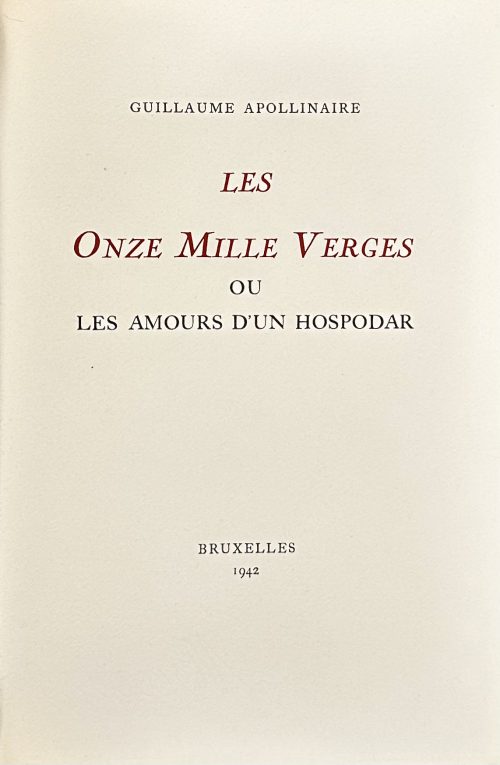 Softcover, 257 x 168 mm, publisher’s cream French flapped wrappers with red lettering to front in a beige double slipcase, printed on wove paper watermarked “Marais” in italic script; edges untrimmed; pp.: [8] [2] [1] 2-130 [131] [3]; collated 4to as 184, 72 leaves incl. those in the wrappers, plus 9 photomechanical stencil-coloured plates extraneous to collation and 9 b/w headpieces (in-text etchings) after anonymous artist. According to the seller and J.-P. Dutel: “In-8 of 130 pages... Illustrated with 10 full-page in colour and some headbands. Limited edition of 500 copies on vélin du Marais". Title-page (red and black): GUILLAUME APOLLINAIRE | LES | ONZE MILLE VERGES | OU | LES AMOURS D'UN HOSPODAR | BRUXELLES | 1942 || Limitation: Il a été tiré de cet ouvrage réservé uniquement aux souscripteurs particuliers 500 exemplaires tous sur vélin du marais. Exemplaire n° 147. Edition: The clandestine edition on vélin de Marais paper limited to 500 copies for subscribers only; this copy is № 147. Catalogue raisonné: Dutel III № 2109. In my copy, similarly to the one of STEVE M., it is only 9 colour plates, while Dutel sites 10. Author: Guillaume Apollinaire (French, 1880 – 1918). Micro photo of a colour plate:
Softcover, 257 x 168 mm, publisher’s cream French flapped wrappers with red lettering to front in a beige double slipcase, printed on wove paper watermarked “Marais” in italic script; edges untrimmed; pp.: [8] [2] [1] 2-130 [131] [3]; collated 4to as 184, 72 leaves incl. those in the wrappers, plus 9 photomechanical stencil-coloured plates extraneous to collation and 9 b/w headpieces (in-text etchings) after anonymous artist. According to the seller and J.-P. Dutel: “In-8 of 130 pages... Illustrated with 10 full-page in colour and some headbands. Limited edition of 500 copies on vélin du Marais". Title-page (red and black): GUILLAUME APOLLINAIRE | LES | ONZE MILLE VERGES | OU | LES AMOURS D'UN HOSPODAR | BRUXELLES | 1942 || Limitation: Il a été tiré de cet ouvrage réservé uniquement aux souscripteurs particuliers 500 exemplaires tous sur vélin du marais. Exemplaire n° 147. Edition: The clandestine edition on vélin de Marais paper limited to 500 copies for subscribers only; this copy is № 147. Catalogue raisonné: Dutel III № 2109. In my copy, similarly to the one of STEVE M., it is only 9 colour plates, while Dutel sites 10. Author: Guillaume Apollinaire (French, 1880 – 1918). Micro photo of a colour plate: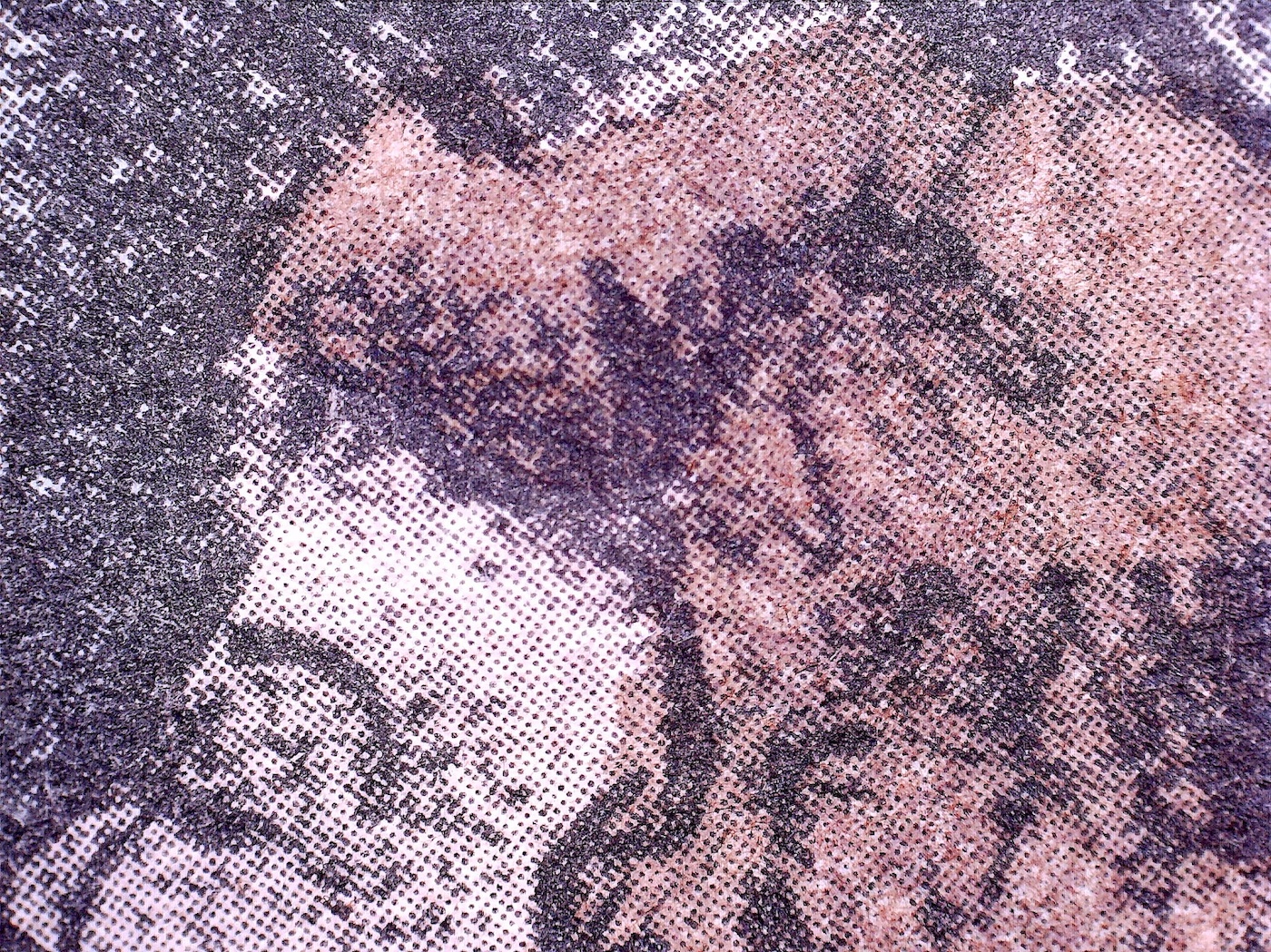 Micro photo of an etching:
Micro photo of an etching:
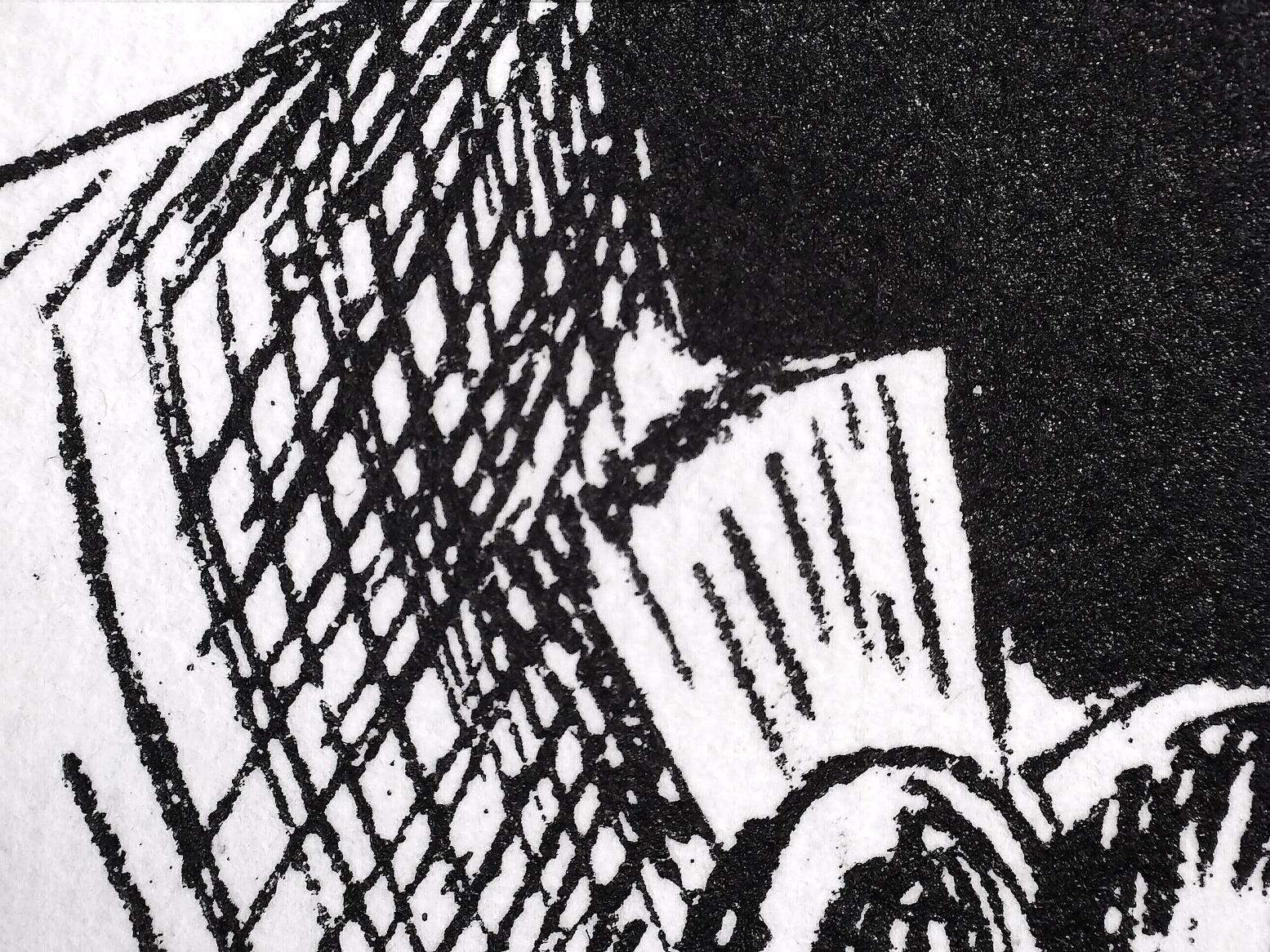
-
 Description: Hardcover, 18.8 x 13 cm, pictorial front cover (after Franz von Bayros) in colour over tan cloth, lettering to spine, all margins red, laid paper endpapers, pp.: [4] 1-185 [3]; collated 8vo as π2 1-118, 126, total 192 pages (96 leaves) plus 5 b/w photogravures after drawings by Franz von Bayros. Title-page (blackletter): Gustav Hochstetter | Das Füsschen der gnädigen Frau | und Anderes | {publisher’s device} | {blank} | 1912 | München und Leipzig bei Georg Müller || T.p. verso (blackletter): Umschlagzeichnung und fünf Bildbeigeben von | Franz von Bayros | {blank} | (serif) Copyright 1912 by Georg Müller in München || Colophon: Druck von Mänicke u. Jahn, Rudolstadt. Contributors: Gustav Hochstetter (German-Jewish, 1873 – 1944) – author. Franz von Bayros (Austrian, 1866 – 1924) – artist. Mänicke und Jahn (Rudolstadt) – printer. Georg Müller (München, Leipzig) – publisher.
Description: Hardcover, 18.8 x 13 cm, pictorial front cover (after Franz von Bayros) in colour over tan cloth, lettering to spine, all margins red, laid paper endpapers, pp.: [4] 1-185 [3]; collated 8vo as π2 1-118, 126, total 192 pages (96 leaves) plus 5 b/w photogravures after drawings by Franz von Bayros. Title-page (blackletter): Gustav Hochstetter | Das Füsschen der gnädigen Frau | und Anderes | {publisher’s device} | {blank} | 1912 | München und Leipzig bei Georg Müller || T.p. verso (blackletter): Umschlagzeichnung und fünf Bildbeigeben von | Franz von Bayros | {blank} | (serif) Copyright 1912 by Georg Müller in München || Colophon: Druck von Mänicke u. Jahn, Rudolstadt. Contributors: Gustav Hochstetter (German-Jewish, 1873 – 1944) – author. Franz von Bayros (Austrian, 1866 – 1924) – artist. Mänicke und Jahn (Rudolstadt) – printer. Georg Müller (München, Leipzig) – publisher. -
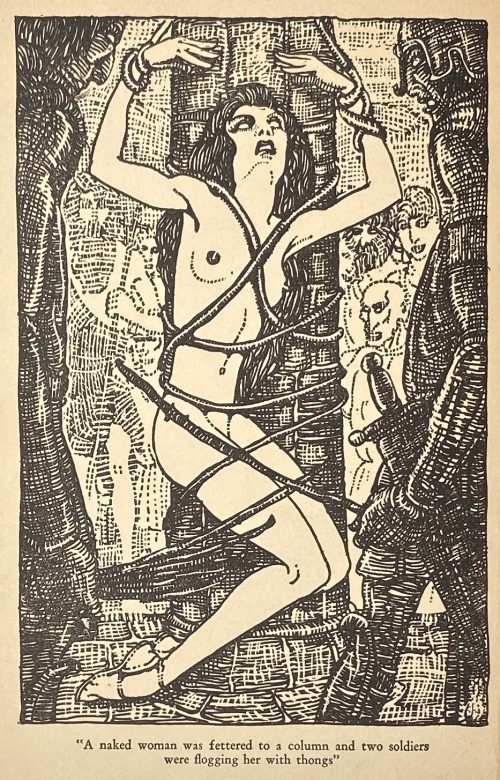 Title (in a frame): THE TEMPTATION | OF ST. ANTHONY | BY | GUSTAVE FLAUBERT | TRANSLATED BY | LAFCADIO HEARN | ILLUSTRATED BY | MAHLON BLAINE | {vignette} | NEW YORK | WILLIAMS, BELASCO | AND MEYERS || Pagination: ffl, [1, 2 - ht, blank] [2 - blank, frontis.] [3, 4 - t.p., colophon] [5, 6 - plate, blank] [7, 8 - list of ill., blank] [9 'argument'] 10-189 [190] bfl; frontispiece and 4 plates reproduced from Blaine's pen drawings in "woodcut" manner. Binding:25.5 x 17 cm., original black cloth, front cover and spine stamped in gilt; printed on thick paper, margins trimmed unevenly; pink pictorial DJ. Contributors: Gustave Flaubert (French, 1821 – 1880) – author. Mahlon Blaine (American, 1894 – 1969) – artist. Patrick Lafcadio Hearn [Koizumi Yakumo; 小泉 八雲] ( Greek-Irish, 1850 – 1904) – translator. Williams, Belasco and Meyers – publisher. J. J. Little & Ives, Co., NY – printer.
Title (in a frame): THE TEMPTATION | OF ST. ANTHONY | BY | GUSTAVE FLAUBERT | TRANSLATED BY | LAFCADIO HEARN | ILLUSTRATED BY | MAHLON BLAINE | {vignette} | NEW YORK | WILLIAMS, BELASCO | AND MEYERS || Pagination: ffl, [1, 2 - ht, blank] [2 - blank, frontis.] [3, 4 - t.p., colophon] [5, 6 - plate, blank] [7, 8 - list of ill., blank] [9 'argument'] 10-189 [190] bfl; frontispiece and 4 plates reproduced from Blaine's pen drawings in "woodcut" manner. Binding:25.5 x 17 cm., original black cloth, front cover and spine stamped in gilt; printed on thick paper, margins trimmed unevenly; pink pictorial DJ. Contributors: Gustave Flaubert (French, 1821 – 1880) – author. Mahlon Blaine (American, 1894 – 1969) – artist. Patrick Lafcadio Hearn [Koizumi Yakumo; 小泉 八雲] ( Greek-Irish, 1850 – 1904) – translator. Williams, Belasco and Meyers – publisher. J. J. Little & Ives, Co., NY – printer. -
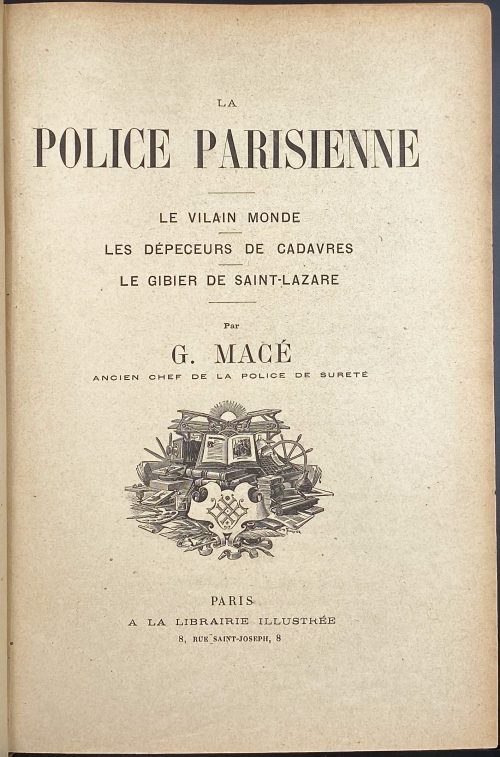 Gustave Macé. La Police parisienne. Le vilain monde. Les dépeceurs de cadavres. Gibier de Saint-Lazare — Paris: Librairie illustrée, [1889]. Title-page: LA | POLICE PARISIENNE |—| LE VILAIN MONDE |—| LES DEPECEURS DE CADAVRES |—| GIBIER DE SAINT-LAZARE |—| Par | G. MACE | ANCIEN CHEF DE LA POLICE DE SURETÉ | {publisher’s device} | PARIS | LIBRAIRIE ILLUSTRÉE | 8, RUE SAINT-JOSEPH, 8 || Description: Hardcover, 4to, 28 x 20 cm, quarter green calf over green marbled boards, raised bands, gilt lettering and gilt fillets to spine, marbled endpapers. Collation:1st bank, [π2 h.t., t.p.], [1]-1074 [108]2 table, last blank; total 432 leaves; 107 woodcuts by Puyplat after E. Mas (on the recto of the first leaf of each complete gathering). Pagination: [4] [1-3] 4-859 [860]; total 864 pp. Edition: Later edition, probably 1889; the 1st edition was published in 1885. Contributors: Gustave Macé (French, 1835 – 1904) – author. Émile Mas (French, 1866 – 1950) – artist. Jules Jacques Puyplat (French, fl. c. 1877 – 1893) – engraver.
Gustave Macé. La Police parisienne. Le vilain monde. Les dépeceurs de cadavres. Gibier de Saint-Lazare — Paris: Librairie illustrée, [1889]. Title-page: LA | POLICE PARISIENNE |—| LE VILAIN MONDE |—| LES DEPECEURS DE CADAVRES |—| GIBIER DE SAINT-LAZARE |—| Par | G. MACE | ANCIEN CHEF DE LA POLICE DE SURETÉ | {publisher’s device} | PARIS | LIBRAIRIE ILLUSTRÉE | 8, RUE SAINT-JOSEPH, 8 || Description: Hardcover, 4to, 28 x 20 cm, quarter green calf over green marbled boards, raised bands, gilt lettering and gilt fillets to spine, marbled endpapers. Collation:1st bank, [π2 h.t., t.p.], [1]-1074 [108]2 table, last blank; total 432 leaves; 107 woodcuts by Puyplat after E. Mas (on the recto of the first leaf of each complete gathering). Pagination: [4] [1-3] 4-859 [860]; total 864 pp. Edition: Later edition, probably 1889; the 1st edition was published in 1885. Contributors: Gustave Macé (French, 1835 – 1904) – author. Émile Mas (French, 1866 – 1950) – artist. Jules Jacques Puyplat (French, fl. c. 1877 – 1893) – engraver. -
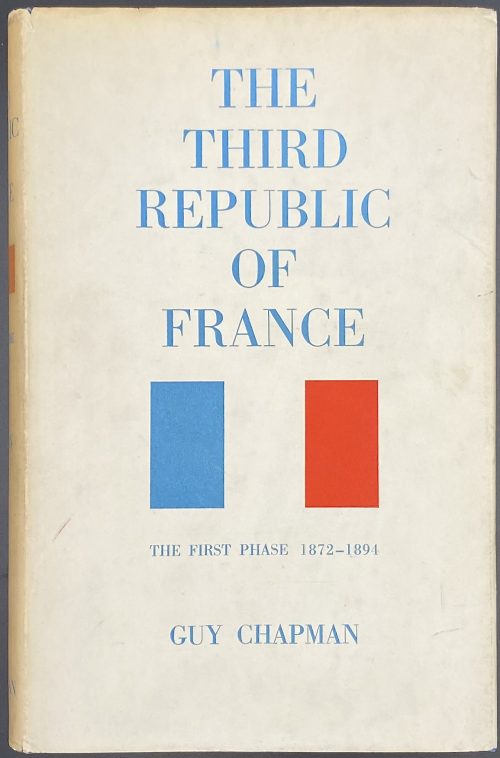 Title: THE | THIRD REPUBLIC | OF FRANCE | THE FIRST PHASE 1871–1894 | BY | GUY CHAPMAN | Sometime Professor of Modern History in the University of Leeds | LONDON | MACMILLAN & CO LTD | NEW YORK • ST. MARTIN’S PRESS | 1962 Pagination: [i-iv] v-xxii, [1] 2-433 [434 imprint]. Collation: 8vo; [A]8 B-Z8 2A-2D8 2E2 2E210. Binding: blue buckram, bronze lettering to spine, pictorial DJ. Publishing year 1963 according to worldcat. Author: Chapman, Guy Patterson (British, 1889 – 1972)
Title: THE | THIRD REPUBLIC | OF FRANCE | THE FIRST PHASE 1871–1894 | BY | GUY CHAPMAN | Sometime Professor of Modern History in the University of Leeds | LONDON | MACMILLAN & CO LTD | NEW YORK • ST. MARTIN’S PRESS | 1962 Pagination: [i-iv] v-xxii, [1] 2-433 [434 imprint]. Collation: 8vo; [A]8 B-Z8 2A-2D8 2E2 2E210. Binding: blue buckram, bronze lettering to spine, pictorial DJ. Publishing year 1963 according to worldcat. Author: Chapman, Guy Patterson (British, 1889 – 1972) -
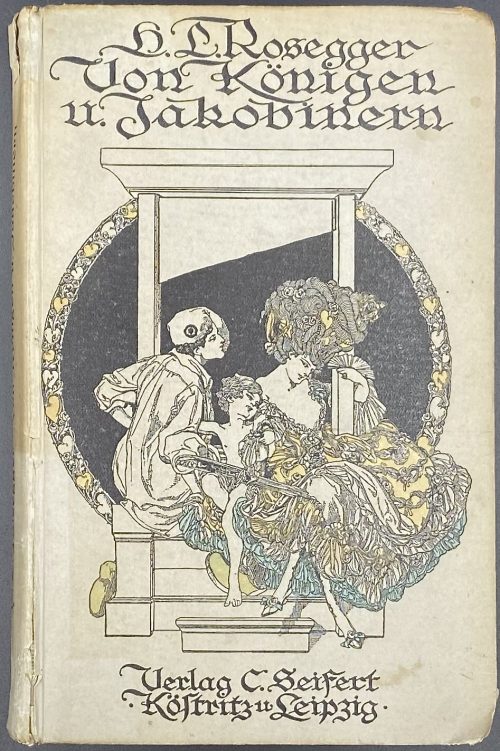 Cover (in blackletter): H. L. Rosegger. | Von Königen u. Jakobinern | {vignette by von Bayros} | Verlag C. Seifert | • Köstritz u Leipzig • || Title (blackletter): Von Königen | und Jakobinern | Von | Hans Ludwig Rosegger | mit vier Vollbildern und Buchschmuck | von Marquis F. von Bayros | {publisher’s device} | 1913 | C. Seifert Verlag, G.m.b.H. | Köstritz und Leipzig || Pagination: [2] – t.p. / blank, [2] – contents / blank, [1-3] 4-263 [264 vignette, colophon], 4 plates extraneous to collation, 2 vignettes. Collation: 8vo; 1-168 174. Binding: Hardcover, pictorial paper boards, lettering to spine, lettering and vignette by von Bayros to cover. Owner's inscription to ffl: "T. Lewe. März, 1919."
Cover (in blackletter): H. L. Rosegger. | Von Königen u. Jakobinern | {vignette by von Bayros} | Verlag C. Seifert | • Köstritz u Leipzig • || Title (blackletter): Von Königen | und Jakobinern | Von | Hans Ludwig Rosegger | mit vier Vollbildern und Buchschmuck | von Marquis F. von Bayros | {publisher’s device} | 1913 | C. Seifert Verlag, G.m.b.H. | Köstritz und Leipzig || Pagination: [2] – t.p. / blank, [2] – contents / blank, [1-3] 4-263 [264 vignette, colophon], 4 plates extraneous to collation, 2 vignettes. Collation: 8vo; 1-168 174. Binding: Hardcover, pictorial paper boards, lettering to spine, lettering and vignette by von Bayros to cover. Owner's inscription to ffl: "T. Lewe. März, 1919." -
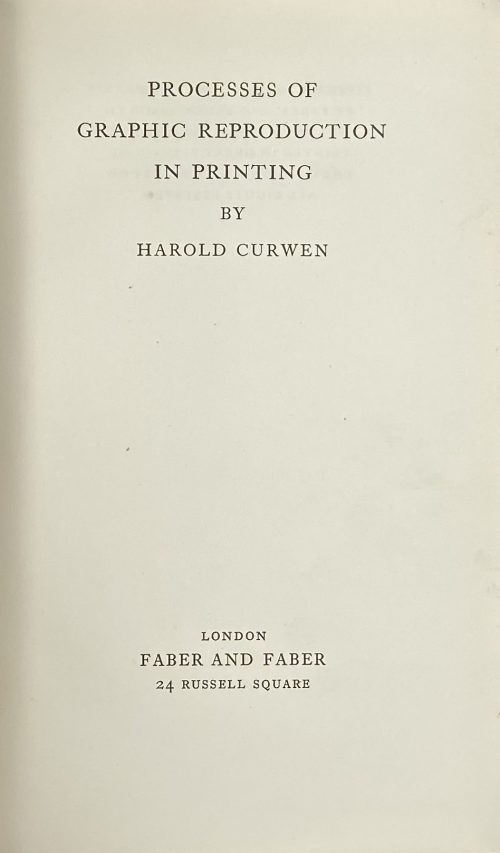 Title: PROCESSES OF | GRAPHIC REPRODUCTION | IN PRINTING | BY | HAROLD CURWEN | [space] | LONDON | FABER AND FABER | 24 RUSSELL SQUARE || Pagination: [i-vii] viii-xvi [6] [1-3] 4-142 [2], ills. Collation: 8vo; π3 [A]8 B-K8, 14 plates extraneous to collation, in-text illustrations; (quire K – 'Binding'). Binding: 22.8 x 15 cm, black cloth, gilt lettering to spine; calligraphic MS bookplate to fep "Dorothy Mahoney | 1942." Edition: 1st edition, printed by The Curwen Press in Plaistow. Contributors: Harold Curwen (British, 1885 – 1949), grandson of John Curwen (British, 1816 – 1880) – author. The Curwen Press (Plaistow, London) – printer. Faber and Faber Limited (London) – publisher. Dorothy Mahoney – provenance; author of the book The Craft Of Calligraphy, first published on October 12th, 1981 by Pelham Books. The 1st American edition was published the same year in New York by Oxford University Press [LIB-2835.2021].
Title: PROCESSES OF | GRAPHIC REPRODUCTION | IN PRINTING | BY | HAROLD CURWEN | [space] | LONDON | FABER AND FABER | 24 RUSSELL SQUARE || Pagination: [i-vii] viii-xvi [6] [1-3] 4-142 [2], ills. Collation: 8vo; π3 [A]8 B-K8, 14 plates extraneous to collation, in-text illustrations; (quire K – 'Binding'). Binding: 22.8 x 15 cm, black cloth, gilt lettering to spine; calligraphic MS bookplate to fep "Dorothy Mahoney | 1942." Edition: 1st edition, printed by The Curwen Press in Plaistow. Contributors: Harold Curwen (British, 1885 – 1949), grandson of John Curwen (British, 1816 – 1880) – author. The Curwen Press (Plaistow, London) – printer. Faber and Faber Limited (London) – publisher. Dorothy Mahoney – provenance; author of the book The Craft Of Calligraphy, first published on October 12th, 1981 by Pelham Books. The 1st American edition was published the same year in New York by Oxford University Press [LIB-2835.2021]. -
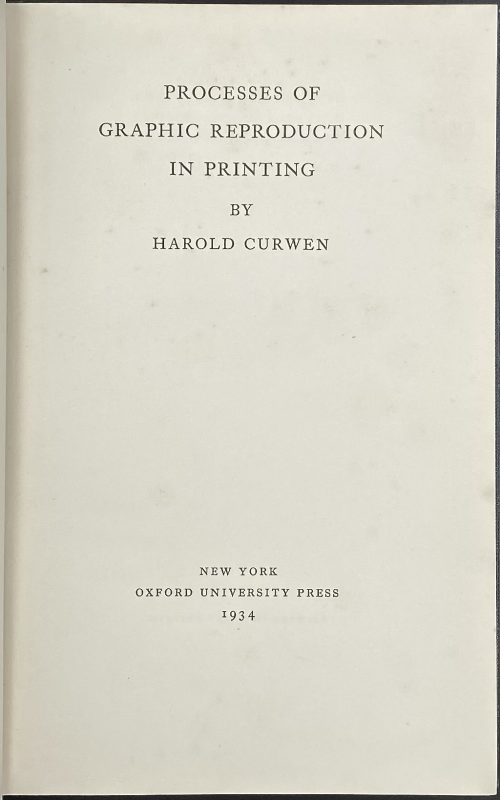 Title: PROCESSES OF | GRAPHIC REPRODUCTION | IN PRINTING | BY | HAROLD CURWEN | [space] | NEW YORK | OXFORD UNIVERSITY PRESS | 1934 || Pagination: [i-vii] viii-xvi [6] [1-3] 4-142 [2], ills. Collation: 8vo; π3 [A]8 B-K8, 14 plates extraneous to collation, in-text illustrations. Binding: 22.5 x 15.5 cm, dark-blue cloth, remnants of gilt lettering to spine. Edition: 2nd (after the 1st published by Faber and Faber in London, printed by The Curwen Press in Plaistow, the same year, 1934 – [LIB-2840.2021]). Contributors: Harold Curwen (British, 1885 – 1949), grandson of John Curwen (British, 1816 – 1880) The Curwen Press (Plaistow, London) – printer.
Title: PROCESSES OF | GRAPHIC REPRODUCTION | IN PRINTING | BY | HAROLD CURWEN | [space] | NEW YORK | OXFORD UNIVERSITY PRESS | 1934 || Pagination: [i-vii] viii-xvi [6] [1-3] 4-142 [2], ills. Collation: 8vo; π3 [A]8 B-K8, 14 plates extraneous to collation, in-text illustrations. Binding: 22.5 x 15.5 cm, dark-blue cloth, remnants of gilt lettering to spine. Edition: 2nd (after the 1st published by Faber and Faber in London, printed by The Curwen Press in Plaistow, the same year, 1934 – [LIB-2840.2021]). Contributors: Harold Curwen (British, 1885 – 1949), grandson of John Curwen (British, 1816 – 1880) The Curwen Press (Plaistow, London) – printer. -
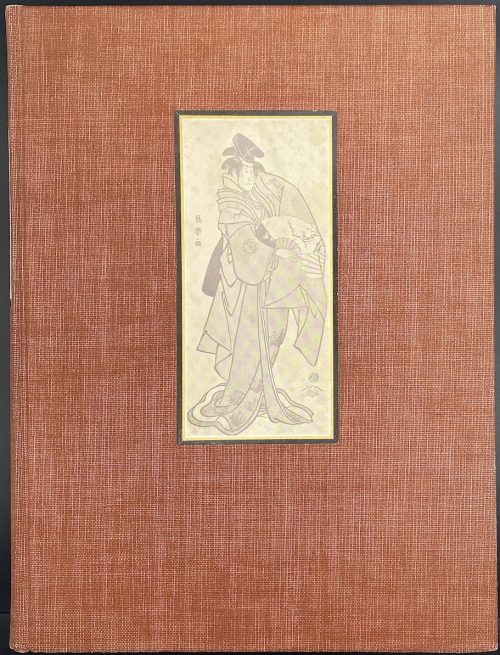 Hardcover volume, 31 x 23.5 cm, bound in full crimson canvas, reproduction colour print with black border pasted to embossed panel, ivory paper label with black lettering to spine, pp.: ffl, [1-4] (t.p./imprint, dedication/blank, 5-337 [338] colophon, 146 b/w woodblock prints by Sharaku photomechanically reproduced, within the pagination. Title-page: THE SURVIVING WORKS OF | SHARAKU | By HAROLD G. HENDERSON | and LOUIS V. LEDOUX | {device} | {blank} | PUBLISHED BY E. WEYNE • NEW YORK | ON BEHALF OF THE | SOCIETY OF THE JAPANESE STUDIES | 1939 || Colophon: PRINTED BY PETER BEILENSON AT THE WALPOLE PRINTING OFFICE | MOUNT VERNON • NEW YORK || Contributors: Harold Gould Henderson (American, 1889 – 1974)– author. Louis Vernon Ledoux (American, 1880 – 1948) – author. Tōshūsai Sharaku [東洲斎 写楽] (Japanese, fl. 1794 – 1795) – artist. Peter Beilenson (American, 1905 – 1962) – printer. Society for Japanese Studies – publisher. Walpole Printing Office (Mount Vernon, NY) – printer
Hardcover volume, 31 x 23.5 cm, bound in full crimson canvas, reproduction colour print with black border pasted to embossed panel, ivory paper label with black lettering to spine, pp.: ffl, [1-4] (t.p./imprint, dedication/blank, 5-337 [338] colophon, 146 b/w woodblock prints by Sharaku photomechanically reproduced, within the pagination. Title-page: THE SURVIVING WORKS OF | SHARAKU | By HAROLD G. HENDERSON | and LOUIS V. LEDOUX | {device} | {blank} | PUBLISHED BY E. WEYNE • NEW YORK | ON BEHALF OF THE | SOCIETY OF THE JAPANESE STUDIES | 1939 || Colophon: PRINTED BY PETER BEILENSON AT THE WALPOLE PRINTING OFFICE | MOUNT VERNON • NEW YORK || Contributors: Harold Gould Henderson (American, 1889 – 1974)– author. Louis Vernon Ledoux (American, 1880 – 1948) – author. Tōshūsai Sharaku [東洲斎 写楽] (Japanese, fl. 1794 – 1795) – artist. Peter Beilenson (American, 1905 – 1962) – printer. Society for Japanese Studies – publisher. Walpole Printing Office (Mount Vernon, NY) – printer -
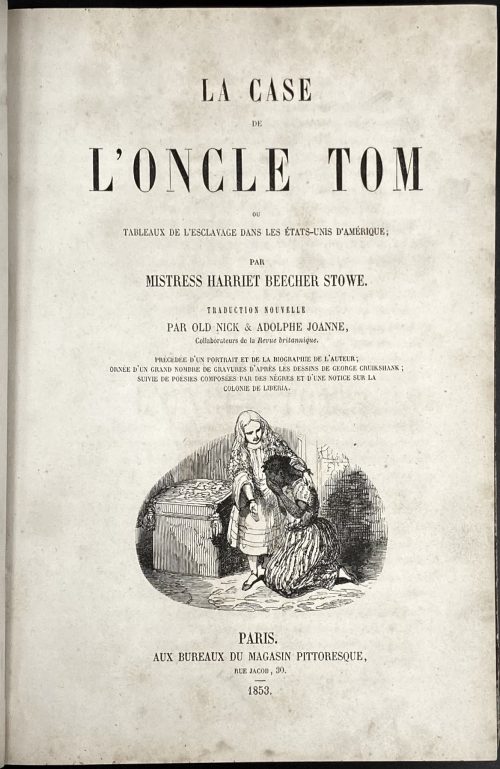 1st French edition (Paris, 1853) of Harriet Beecher Stowe's book Uncle Tom's Cabin; or, Life Among the Lowly, with 27 illustrations on wood by George Cruikshank (British, 1792 – 1878), translated into French by Paul-Émile Daurand-Forgues [pseudonym Old Nick] (French, 1813 – 1883) and Adolphe Joanne (French, 1813 – 1881). Title: LA CASE | DE | L'ONCLE TOM | OU | TABLE AUX DE L'ESCLAVAGE DANS LES ÉTATS-UNIS D'AMÉRIQUE ; | PAR MISTRESS HARRIET BEECHER STOWE. | TRADUCTION NOUVELLE | PAR OLD NICK & ADOLPHE JOANNE, | Collaboarteurs de la Revue britannique, | PRÉCÉDÉE D'UN PORTRAIT ET DE LA BIOGRAPHIE DE L'AUTEUR; | ORNÉE D'IU GRAND NOMBRE DE GRAVURES D'APRES LES DESSINS DE GEORGE CRUIKSHANK ; | SUIVIE DE POÉSIES COMPOSÉES PAR DES NÈGRES ET D'UNE NOTICE SUR LA | COLONIE DE LIBERIA. | [vignette] | PARIS. | AUX BUREAUX DU MAGASIN PITTORESQUE, | RUE JACOB, 30. | 1853. Pagination: ffl blank; [i-ii]: h.t. with stamped letters D. W. in the upper centre / imprim. to verso; [iii-iv] t.p. / blank; [v-vi] blank / frontispiece: portrait of Harriet Beecher Stowe, half-length to left, with hair in ringlets, and a shawl over shoulders, landscape behind, Henry Linton (British, 1815 – 1899) after Henry Anelay (British,1817 – 1883), wood-engraving with letterpress; [vij] Viij-xij; [1] 2-563 [564]; bfl blank; illustrations: 27 woodcuts by George Cruikshank. Collation: 8vo, π7 (1)–(35)8 363 Binding: Quarter brown calf, spine with raised bands, gilt-ruled compartments, title lettering, "D. W." in the bottom, marbled boards and endpapers. Dimensions: 24.1 x 16.4 cm. Catalogue raisonné: Albert M. Cohen (1924), №777, p. 221. "An edition was published in French with the woodcuts direct from the blocks, not, as in the English, merely from the stereotypes. The illustrations are far more impressive than those of Cassell's edition".
1st French edition (Paris, 1853) of Harriet Beecher Stowe's book Uncle Tom's Cabin; or, Life Among the Lowly, with 27 illustrations on wood by George Cruikshank (British, 1792 – 1878), translated into French by Paul-Émile Daurand-Forgues [pseudonym Old Nick] (French, 1813 – 1883) and Adolphe Joanne (French, 1813 – 1881). Title: LA CASE | DE | L'ONCLE TOM | OU | TABLE AUX DE L'ESCLAVAGE DANS LES ÉTATS-UNIS D'AMÉRIQUE ; | PAR MISTRESS HARRIET BEECHER STOWE. | TRADUCTION NOUVELLE | PAR OLD NICK & ADOLPHE JOANNE, | Collaboarteurs de la Revue britannique, | PRÉCÉDÉE D'UN PORTRAIT ET DE LA BIOGRAPHIE DE L'AUTEUR; | ORNÉE D'IU GRAND NOMBRE DE GRAVURES D'APRES LES DESSINS DE GEORGE CRUIKSHANK ; | SUIVIE DE POÉSIES COMPOSÉES PAR DES NÈGRES ET D'UNE NOTICE SUR LA | COLONIE DE LIBERIA. | [vignette] | PARIS. | AUX BUREAUX DU MAGASIN PITTORESQUE, | RUE JACOB, 30. | 1853. Pagination: ffl blank; [i-ii]: h.t. with stamped letters D. W. in the upper centre / imprim. to verso; [iii-iv] t.p. / blank; [v-vi] blank / frontispiece: portrait of Harriet Beecher Stowe, half-length to left, with hair in ringlets, and a shawl over shoulders, landscape behind, Henry Linton (British, 1815 – 1899) after Henry Anelay (British,1817 – 1883), wood-engraving with letterpress; [vij] Viij-xij; [1] 2-563 [564]; bfl blank; illustrations: 27 woodcuts by George Cruikshank. Collation: 8vo, π7 (1)–(35)8 363 Binding: Quarter brown calf, spine with raised bands, gilt-ruled compartments, title lettering, "D. W." in the bottom, marbled boards and endpapers. Dimensions: 24.1 x 16.4 cm. Catalogue raisonné: Albert M. Cohen (1924), №777, p. 221. "An edition was published in French with the woodcuts direct from the blocks, not, as in the English, merely from the stereotypes. The illustrations are far more impressive than those of Cassell's edition". -
 This print was sold to me with the following description: "Ikkansai EISHO (Fl. early 19th c.). A portrait of the wrestler Kuroyanagi Matsujiro, ring name Kumagatake Inosuke. Eisho was a pupil of Eishi. Published c. 1820s by Uoya Eikichi. Signed Shunsai Eisho ga." As a result of our joint effort with my beloved sister, we have so far found the following: The artis is mentioned in The Hotei Encyclopedia of Japanese Woodblock Prints, 2005, Vol 2; p. 438 under the name of Harukawa Eichō. From this source we learned that the artist was active from about 1818 till 1844, and was a print designer in Kyoto. He was a student first of Harukawa Goshichi and later studied in Edo (Tokyo) with Keisai Eisen, when he assumed the art name 'Eichō'. Other names: Shunsai. The Japanese web page dedicated to Harukawa Eichō provides more details: The artist lived from the 4th year of Tenmei ( 1784 ) to the first year of Kaei ( 1848 ). He was a student of Harukawa Goshichi, Kikukawa Eizan as well as of Keisai Eisen. His popular name was Kamenosuke. He was from Kyoto. He took "gagō" (artistic names) of Eishō when he was a student of Harukawa Goshichi; later, when he became a student of Kikukawa Eizan and Keisai Eisen he took the name of Kikukawa Eichō. The artist was mostly known for his bijinga (beautiful women) prints as well as kanazōshi illustrations. Nothing is said anywhere about his sumo prints, though the reference to another Kyushu sumo wrestler portrait has been found. The sumo wrestler Kuroyanagi Matsujiro is also a somewhat obscure figure: information about his life and career is quite inconsistent. It may so happened that two different persons were combined together. Wikipedia page about Aoi Aso Jinja, a Shinto shrine in Hitoyoshi in Kumamoto prefecture, tells us the following:This information has some inconsistencies already. If our hero was born in 1807 and promoted to ōzeki at the age of 32, it should have been the year 1839, not 1847. I found Kumagatake Isuke at "Sumo Reference" website:
This print was sold to me with the following description: "Ikkansai EISHO (Fl. early 19th c.). A portrait of the wrestler Kuroyanagi Matsujiro, ring name Kumagatake Inosuke. Eisho was a pupil of Eishi. Published c. 1820s by Uoya Eikichi. Signed Shunsai Eisho ga." As a result of our joint effort with my beloved sister, we have so far found the following: The artis is mentioned in The Hotei Encyclopedia of Japanese Woodblock Prints, 2005, Vol 2; p. 438 under the name of Harukawa Eichō. From this source we learned that the artist was active from about 1818 till 1844, and was a print designer in Kyoto. He was a student first of Harukawa Goshichi and later studied in Edo (Tokyo) with Keisai Eisen, when he assumed the art name 'Eichō'. Other names: Shunsai. The Japanese web page dedicated to Harukawa Eichō provides more details: The artist lived from the 4th year of Tenmei ( 1784 ) to the first year of Kaei ( 1848 ). He was a student of Harukawa Goshichi, Kikukawa Eizan as well as of Keisai Eisen. His popular name was Kamenosuke. He was from Kyoto. He took "gagō" (artistic names) of Eishō when he was a student of Harukawa Goshichi; later, when he became a student of Kikukawa Eizan and Keisai Eisen he took the name of Kikukawa Eichō. The artist was mostly known for his bijinga (beautiful women) prints as well as kanazōshi illustrations. Nothing is said anywhere about his sumo prints, though the reference to another Kyushu sumo wrestler portrait has been found. The sumo wrestler Kuroyanagi Matsujiro is also a somewhat obscure figure: information about his life and career is quite inconsistent. It may so happened that two different persons were combined together. Wikipedia page about Aoi Aso Jinja, a Shinto shrine in Hitoyoshi in Kumamoto prefecture, tells us the following:This information has some inconsistencies already. If our hero was born in 1807 and promoted to ōzeki at the age of 32, it should have been the year 1839, not 1847. I found Kumagatake Isuke at "Sumo Reference" website:Kuroki Matsujiro (黒木松次郎) was born in the village of Itsuki in Kuma district, Kumamoto prefecture, island of Kyushu in Bunka era, 4th year (1807). Since from his childhood he was blessed by great physique and tough strength. He had affection for sumo. At the age of 18 he became a sumo student of Kumamoto Shimakawa Ikuhei and took the name of Toyama Hidekichi (遠山日出吉). At the age of 23 (1830), he entered sumo stables in Kyoto, mastered the art of taming of young horses, and his talents improved. At the age of 31 he went to Edo, and became a disciple of the ōzeki Oitekaze Kitaro of Hirado domain in Hizen province, also from Kyushu island. After that, he changed his name and became Kuroyanagi Matsujiro (黒柳松次郎 – as on the print). In 1847 (Bunka era, 4th year) he distinguished himself by advancing to the first grade, and at the age of 32 he was promoted to ozeki level, becoming sekitori. After changing his name to Kuma-ga-take Inosuke (熊ヶ嶽猪之介 / くまがたけいのすけ) he displayed further efforts, and became one of the strongmen that fermented sumo wrestling in Edo. In 1853 (Kaei era, 6th year) he retired and returned to his village, becoming an employee as a strongman of Sagara domain (相良藩), and worked hard as instructor of the sumo training hall to train successors until 1855 (Ansei era, 2nd year) when he passed away at the age of 48. Even today Kuma-ga-take's home exists in Itsukimura (his native village). Also, on those grounds a descendant of Kuma-ga-take runs minshuku (guest house) that bears the name of "The Kuroki Pension (lodging) ", and tourists come to visit from various parts of Japan. In 2015, tenth month, within the borders of Aoi Aso Shrine there was built a gravestone publicly honoring Kuma-ga-take Inosuke, sumo wrestler from Edo / of Edo period.
The real name is the same, the ring name Kuroyanagi Matsujiro is the same, however, the date of birth here is 1815. He fought from 1836 till 1853 - which is quite similar to "At the age of 31 he went to Edo, and became a disciple of the ōzeki Oitekaze Kitaro". Though, in 1836 he might be 29 years old. His bouts are listed from spring 1841 to spring 1848 under the name of Kuroyanagi and from winter 1848 till spring 1853 he listed under the name of Kumagatake Isuke [Inosuke].Highest Rank Maegashira 4 Real Name Kuroki Birth Date 1815 Shusshin Kumamoto-ken, Kuma-gun Death Date March 6, 1855 (40 years) Heya Oitekaze Shikona Kuroyanagi Matsujiro - Kumagatake Isuke Hatsu Dohyo 1836.02 (Sandanme) Intai 1853.02 On another important sumo history website, I found that Kuroyanagi first appeared at ring in the spring of 1823 (he might have been 16 years old then, which does not seem right). Then, in the winter tournament of 1848 Kuroyanagi took the name Kumagatake. At the spring tournament of 1853 Kumagatake (Kuroyanagi) retired. This is quite consistent so far.
Then, I found Oitekaze Kitaro, allegedly the teacher of Kuroyanagi.
Everything look good with an exception of ring names (shikona): Kuroyanagi Matsujiro (1823-1828) - Kuroyanagi Sumiemon (1829-30) - Oitekaze Kitaro (1831-1839). May it be that Sato Matsutaro fought under the name of Kuroyanagi Matsujiro until Kuroki Matsujiro took this name from his master? I don't have another explanation of the enigma. What we know is that we have a portrait of a sumo wrestler called Kuroyanagi Matsujiro from Kyushu, but we don't know whether this was the one from Kumamoto (Kumagatake Inosuke, 1807/1815-1855) or the other from Kanagawa (Oitekaze Kitaro, 1799-1865). Subsequently, we may declare that the artist is Shunsai Eishō, a.k.a.Harukawa Eichō from Eishi school (The Hotei Encyclodepdia, p. 524), we can date the print from 1818 to 1844, and only tell that the wrestler is Kuroyanagi Matsujiro from Kyushu (either Kumagatake Inosuke or Oitekaze Kitaro). The publisher of the print is Moriya Jihei (Marks №353, p. 243-5). That's it.Highest Rank Ozeki Real Name SATO Matsujiro (Matsutaro#) Birth Date 1799 Shusshin Kanagawa-ken, Tsukui-gun Death Date May 4, 1865 (66 years) Heya Oitekaze Shikona Kuroyanagi Matsujiro - Kuroyanagi Sumiemon - Oitekaze Kitaro Hatsu Dohyo 1817.10 (Jonokuchi) Intai 1839.03 -
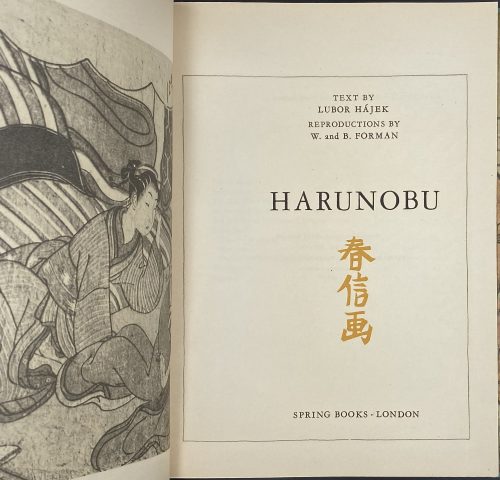 Japanese binding, 2 leaves of pictorial wrappers, [10] 11-63, 10 b/w plates, 63 colour plates within pagination; in a green cloth folder with gilt lettering to front and spine.
Japanese binding, 2 leaves of pictorial wrappers, [10] 11-63, 10 b/w plates, 63 colour plates within pagination; in a green cloth folder with gilt lettering to front and spine. -
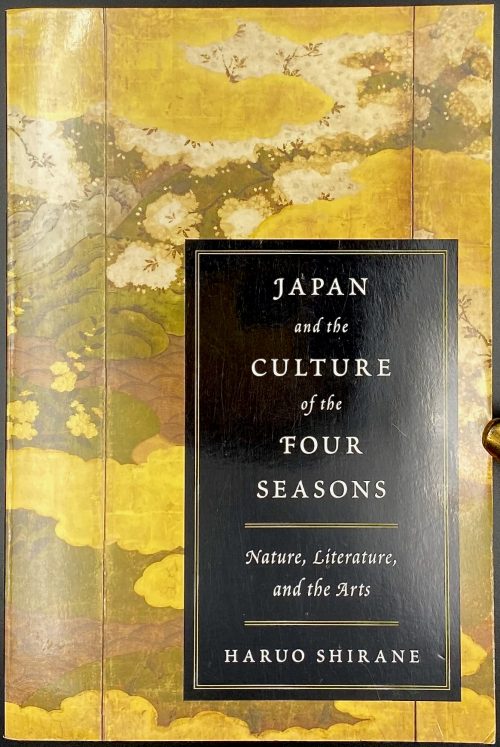 Paperback, 23 x 15.5 cm, pictorial wrappers, pp. [i-xxi] [3] [1] 2-311 [312 blank], total 336 pages. Title-page: Japan | and the | Culture | of the | Four Seasons | Nature, Literature, and the Arts | HARUO SHIRANE | Columbia University Press New York ||
Paperback, 23 x 15.5 cm, pictorial wrappers, pp. [i-xxi] [3] [1] 2-311 [312 blank], total 336 pages. Title-page: Japan | and the | Culture | of the | Four Seasons | Nature, Literature, and the Arts | HARUO SHIRANE | Columbia University Press New York ||


